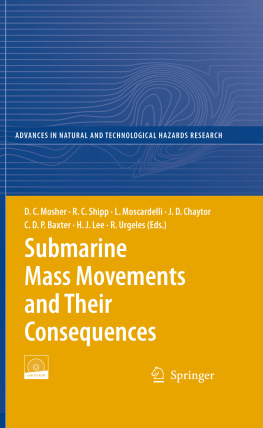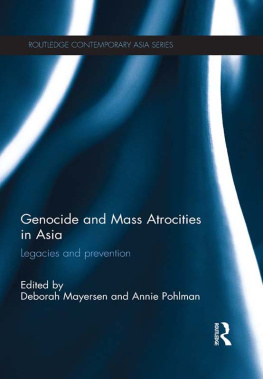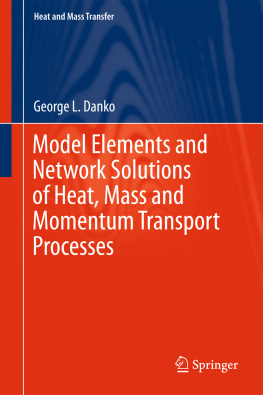Part 1
part 1
David C. Mosher , R. Craig Shipp , Lorena Moscardelli , Jason D. Chaytor , Christopher D. P. Baxter , Homa J. Lee and Roger Urgeles (eds.) Advances in Natural and Technological Hazards Research Submarine Mass Movements and Their Consequences 10.1007/978-90-481-3071-9_1 Springer Science+Business Media B.V. 2010
Submarine Mass Movements and Their Consequences
D. C. Mosher 1
(1)
Natural Resources Canada, Dartmouth, NS, Canada
(2)
Shell International, Exploration and Production Inc., Houston, TX, USA
(3)
University of Texas, Austin, TX, USA
(4)
Woods Hole Oceanographic Institution, Woods Hole, MA, USA
(5)
University of Rhode Island, Narragansett, RI, USA
(6)
United States Geological Survey, Menlo Park, CA, USA
(7)
Departament d'Estratigrafi a, Paleontologia i Geocincies Marines, Universitat de Barcelona, Mart i Franqus, s/n, Barcelona, Catalonia, 08028, Spain
In 1929, an earthquake off the Grand Banks of Newfoundland initiated a submarine mass movement that sheared undersea communication cables and generated a tsunami that resulted in deaths of 27 people along the south coast of Newfoundland. This event initiated the modern realization that the seafloor is a dynamic environment with potential to do harm. More recent catastrophic examples include submarine mass movements off the Nice airport in 1979 that removed part of the runway along with construction equipment and resulted in the loss of several construction workers (Dan et al. 2007; Kopf et al. this volume), and a 1998 event off Papua, New Guinea that caused a tsunami resulting in 2200 deaths (Tappin et al. 2001). On December 26, 2006, a submarine landslide in the Luzon Strait caused failure of undersea cables (Hsu et al. 2009), halting the entire internet network between Taiwan, Hong Kong, and China and affecting communications between Thailand, Malaysia, Vietnam, South Korea and Singapore for 12 h. Given that the combined GDP of Taiwan, Hong Kong and China approximates $7.56 billion per day, the economic impact of this event was severe. As for the offshore hydrocarbon industry, aside from direct risk to exploration and production platforms, the Society for Underwater Technology estimates that the cost of damage to pipelines caused by submarine mass movements is about $400 million annually. As a result of instances like these and the potential economic and societal impact (an estimated 2.75 billion people worldwide live within 60 km of the coast), an interest in understanding the phenomenon of submarine mass movements has led to concerted efforts on behalf of governmental, non-governmental and international agencies to understand this risk to society, e.g. the United States Nuclear Regulatory Commission, the US National Tsunami Hazard Mitigation Program, the European and Canadian Continental Slope Stability (COSTA) Program, the Integrated Ocean Drilling Program and the joint United Nations Educational Scientific and Cultural Organization's (UNESCO) and International Union of Geosciences (IUGS) International Geosciences Program (IGCP) Project 511. The objective of IGCP project 511 is to bring a world-wide perspective to submarine mass movements and their consequences. This objective is realized by assembling excellent contributions from active researchers, groups and institutions to provide diverse coverage of the many scientific and engineering aspects of this type of marine and coastal geohazard. To this end, this project has hosted four international symposia, the latest of which is represented by this volume. Previous symposia resulted in two books (Lykousis et al. 2007; Locat and Meinert 2003) and a special issue in the Norwegian Journal of Geology (Solheim 2006).
Introduction
In 1929, an earthquake off the Grand Banks of Newfoundland initiated a submarine mass movement that sheared undersea communication cables and generated a tsunami that resulted in deaths of 27 people along the south coast of Newfoundland. This event initiated the modern realization that the seafloor is a dynamic environment with potential to do harm. More recent catastrophic examples include submarine mass movements off the Nice airport in 1979 that removed part of the runway along with construction equipment and resulted in the loss of several construction workers (Dan et al. ), halting the entire internet network between Taiwan, Hong Kong, and China and affecting communications between Thailand, Malaysia, Vietnam, South Korea and Singapore for 12 h. Given that the combined GDP of Taiwan, Hong Kong and China approximates $7.56 billion per day, the economic impact of this event was severe. As for the offshore hydrocarbon industry, aside from direct risk to exploration and production platforms, the Society for Underwater Technology estimates that the cost of damage to pipelines caused by submarine mass movements is about $400 million annually.
As a result of instances like these and the potential economic and societal impact (an estimated 2.75 billion people worldwide live within 60 km of the coast), an interest in understanding the phenomenon of submarine mass movements has led to concerted efforts on behalf of governmental, non-governmental and international agencies to understand this risk to society, e.g. the United States Nuclear Regulatory Commission, the US National Tsunami Hazard Mitigation Program, the European and Canadian Continental Slope Stability (COSTA) Program, the Integrated Ocean Drilling Program and the joint United Nations Educational Scientific and Cultural Organization's (UNESCO) and International Union of Geosciences (IUGS) International Geosciences Program (IGCP) Project 511. The objective of IGCP project 511 is to bring a world-wide perspective to submarine mass movements and their consequences. This objective is realized by assembling excellent contributions from active researchers, groups and institutions to provide diverse coverage of the many scientific and engineering aspects of this type of marine and coastal geohazard. To this end, this project has hosted four international symposia, the latest of which is represented by this volume. Previous symposia resulted in two books (Lykousis et al. ).
The Fourth International Symposium on Submarine Mass Movements and their Consequences called for manuscript submissions, addressing the broad issues of submarine mass movements, and meeting the objectives of the project to bring together in a common forum experts from all disciplines pertinent to the topic. This volume is the result: a collection of 62 papers spanning subjects broadly organized under topics of: (1) triggers; mechanics and geotechnical properties; (2) case studies and hazard assessment; (3) margin construction and economic significance; and (4) tsunami genesis from submarine mass movements.
Submarine Mass Movement Triggers, Mechanics and Geotechnical Properties
A fundamental aspect of submarine mass movement research is understanding trigger mechanisms. This research component, however, is not well developed. In this section, authors explore the role of pore pressure and fluid and gas migration in slope instability. As Masson et al. (this volume) indicate, elevated pore pressures are often essential for mass movement initiation, yet understanding how high pore pressures are generated or how fluid migration affects slope stability is limited. Sediments may be pre-conditioned for failure by the processes that originally deposited them, but the processes and parameters that might control this factor are largely unknown. Continental margin development might also result in focussed fluid flow and elevated pore pressures where sedimentation rates are not particularly high, indicating that margin architecture also plays a significant role in overpressure and the most likely place for occurrence of submarine slope failures (Dugan et al. this volume, Urgeles et al. this volume).










